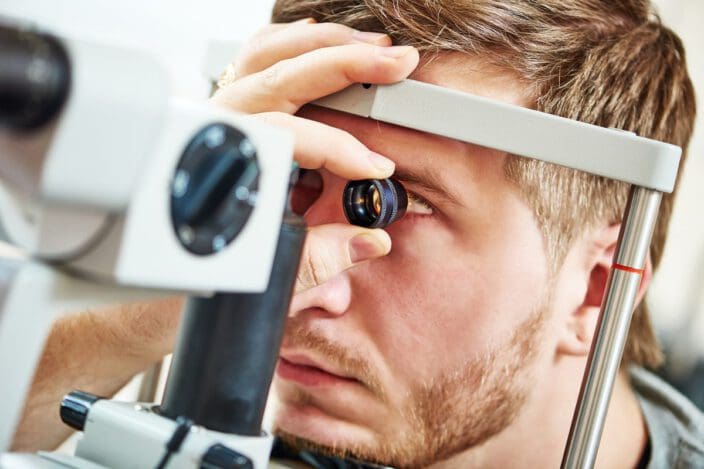
Medically Reviewed by Huy Q. Ly, M.D. NVISION Surgeon
Testing for Glaucoma: What Makes a Comprehensive Glaucoma Exam?
Home / Eye Health and Preventive Care /
Last Updated:

Medically Reviewed by Huy Q. Ly, M.D. NVISION Surgeon
A comprehensive eye exam checks the pressure of your eye, the state of your optic nerve, your field of vision, the thickness of your cornea, and the angle at which your iris meets your cornea. This generally involves a noninvasive battery of tests, which doesn’t take very long to complete.
Table of Contents

What Tests Do Doctors Use to Check for Glaucoma?
Optometrists and ophthalmologists use a variety of tests to check for glaucoma during a standard eye exam.
Visual Acuity Assessment
This is what many people view as the “standard” vision test, where a patient has one eye covered and attempts to read several letters on a chart, with each line of letters on the chart decreasing in size. If you cannot read or have a very low level of visual acuity that prevents you from making out any letters, an alternate test using pictures or counting a doctor’s fingers is used.
You deserve clear vision. We can help.
With 135+ locations and over 2.5 million procedures performed, our board-certified eye surgeons deliver results you can trust.
Your journey to better vision starts here.
A visual acuity assessment is used to see if a patient has lost any vision as a result of glaucoma.
Visual Field Test
This test is called perimetry. It involves looking straight ahead as a doctor tests you with a machine that will flash lights in your periphery. The goal is to press a button when you see the light, helping your doctor determine whether your peripheral vision is normal or reduced.
If you have glaucoma, you may have a reduced field of vision.
Pupil Examination
During a pupil examination, a doctor checks your pupils in both light and darkness. Part of this test involves using a light to see how your eyes react to it.
One of the main purposes of this test is to see if either eye has an afferent defect, which basically means the eye doesn’t react to light as a healthy eye should. A nonreactive pupil can be a sign of glaucoma.
Anterior Segment Examination
Using a device called a slit lamp, in an anterior segment exam, a patient will rest their forehead and chin on a machine that allows the doctor to look over their eyes. The doctor looks for many different things during this test, including these:
- Signs of irritation
- Signs of inflammation
- Pigment irregularities
- Lesions
- Asymmetry
- Abnormalities in the lenses
- Foreign bodies in the eye
IOP Measurement
This is one of the most important tests for glaucoma.
An intraocular pressure (IOP) test measures fluid pressure inside your eye. There are several ways to measure this, with many of the modern testing devices using a puff of air and some complex calculations to measure the pressure in your eye.
While many patients find this test a bit uncomfortable, any irritation is generally very brief. It is more the surprise of the air rather than any pain that often causes patients anxiety.
Optic Nerve Examination
The optic nerve is a critical part of how your eye sends information to your brain. Examining this part of the eye is also done with a slit lamp, likely at the same time your doctor is performing other tests with the same device.
Glaucoma causes damage to the optic nerve.
Fundus Examination
This exam is performed with an ophthalmoscope, a very common tool used to examine the eye. This small, handheld device is basically a magnifying lens combined with a light to help your doctor see into your eye.
Your doctor can quickly review key parts of your eye for any obvious issues. This quick exam helps doctors to identify areas they might want to observe more closely.
Why Are There Multiple Glaucoma Tests?
There are various reasons why a comprehensive glaucoma screening involves multiple tests.
- Glaucoma is the most common cause of irreversible blindness in the world.
- Damage caused by glaucoma is generally permanent.
- Catching glaucoma early can help slow or even prevent vision loss.
- Glaucoma progresses slowly, and its early signs can be very subtle.
- A patient may show signs of glaucoma in some areas but not others. This means some tests, even when performed perfectly, cannot provide the necessary information for a diagnosis.
In a thorough exam, a doctor doesn’t determine whether you have glaucoma, and how it may have progressed if you do have it until they have observed all or most parts of the ocular system that it might affect. This can ensure they have a reasonable level of confidence you have glaucoma and help them develop the best possible treatment plan for you.
You deserve clear vision. We can help.
With 135+ locations and over 2.5 million procedures performed, our board-certified eye surgeons deliver results you can trust.
Your journey to better vision starts here.
What to Expect After a Glaucoma Test
A comprehensive glaucoma test likely involves dilating your eyes, so you will need help getting home. You may be given special glasses to wear to prevent excess light from entering your eyes.
Talk to your doctor about when you can safely drive again. Most people’s eyes return to normal dilation levels within a day, often sooner.
If your doctor diagnosed you with glaucoma, you’ll be given information about how to proceed. Depending on the severity of your case, you may receive prescription eye drops to use regularly or oral medications. In some cases, your doctor may recommend laser treatment or surgery.
Glaucoma Test FAQs
How do they test for glaucoma?
A comprehensive, reliable glaucoma test involves checking multiple parts of the eye for signs of glaucoma. One part of this test is usually what many call the “puff test,” where a small puff of air is blown into the eye to check its pressure. This is what most people associate with a glaucoma test.
Your eye will likely be dilated, so the doctor can better examine it during some parts of the exam.
What is the most accurate glaucoma test?
Many people hold up optical coherence tomography (OCT) devices as the gold standard in glaucoma testing, as they can detect glaucoma in its very early stages. However, experts haven’t reached a consensus on whether it is appropriate for general screening rather than for particularly at-risk groups.
Regardless, the “most accurate” glaucoma test is a comprehensive exam, as it will test multiple parts of the eye.
Is a glaucoma test part of a standard eye exam?
Not all eye exams check for glaucoma, but most do. It’s important to talk with your eye doctor about how regularly you should get screened for glaucoma and make sure the tests you’re scheduling are going to cover everything they recommend in a screening.
Confirm you are receiving a comprehensive eye exam rather than only a visual acuity test.
You deserve clear vision. We can help.
With 135+ locations and over 2.5 million procedures performed, our board-certified eye surgeons deliver results you can trust.
Your journey to better vision starts here.
References
- Chapter 117: The Funduscopic Examination. (1990). Clinical Methods: The History, Physical, and Laboratory Examinations, 3rd Edition.
- Five Common Glaucoma Tests. (February 2022). Glaucoma Research Foundation.
- Types of Glaucoma. (October 2017). Glaucoma Research Foundation.
- Childhood Glaucoma. The Children’s Hospital of Philadelphia.
- Glaucoma Screening. (February 2022). American Academy of Ophthalmology.
- How Is the Optic Nerve Examined? Glaucoma Patients.
- Optical Coherence Tomography as a Glaucoma Screening Tool. (May 2016). Glaucoma Today.
- Slit Lamp Examination. American Academy of Ophthalmology.
- The Assessment of Pupils and Pupillary Reactions. (October 2015). EyeNews.
- Visual Acuity Test. (March 2021). MedlinePlus.
- What Is the Real IOP? (August 2016). Glaucoma Today.
- Glaucoma in Adults—Screening, Diagnosis, and Management. (January 2021). JAMA.
- Diagnostic Accuracy of Glaucoma Tests in Everyday Practice. (September 2017). Ophthalmology @Point of Care.

Dr. Huy Ly is a board-certified ophthalmologist specializing in the medical and surgical management of cataracts and glaucoma. In addition to performing the latest cutting-edge cataract techniques, he is also an expert in minimally invasive techniques for treating glaucoma, including laser trabeculoplasty, goniotomy, micropulse diode cyclophotocoagulation, and various minimally invasive stent devices.
This content is for informational purposes only. It may have been reviewed by a licensed physician, but is not intended to serve as a substitute for professional medical advice. Always consult your healthcare provider with any health concerns. For more, read our Privacy Policy and Editorial Policy.
